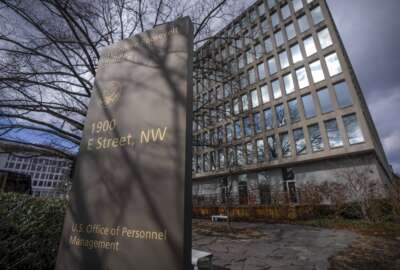DCMA leads acquisition ‘revolution’
The Defense Department said it intends to not just rebuild its acquisition workforce in numbers, but also make sure those employees have access to new tools that...
wfedstaff | June 4, 2015 2:03 pm
The Defense Department says it’s taking several new steps designed to drive toward better business deals. They involve not only rebuilding the acquisition workforce, but also making sure that workforce has the tools to make good decisions.
The acquisition workforce is one of the few areas that’s been protected from the Pentagon’s civilian hiring freeze. DoD is trying to rebuild capacities the department let atrophy beginning in the 1990s. That workforce is being slowly and steadily rebuilt. But at the same time, DoD says it’s trying to deliver decision-making tools to that workforce it says are long overdue. 
“When I was on the other side of the street in industry, we certainly knew what was going on within all the different divisions across the Department of Defense,” said Assad, who served as an executive at Raytheon for several years. “But the thing I could count on was if I went to the [Naval Sea Systems Command], I could pretty much count on the fact that they weren’t paying much attention to what was happening in the [Naval Air Systems Command]. Those days are gonna change. There will be much more awareness across the department. As we act like an integrated enterprise, you will get a much more consistent position from our contracting officers.”
DCMA to take the lead
The changes will be led by the Defense Contract Management Agency, the DoD entity that handles administration of contracts, Assad told attendees at a conference of the Government Contract Management Conference in Bethesda, Md.
Assad said DoD is starting by bringing all of DCMA’s administrative contracting officers (ACOs) back into one place after a period of decentralization.
“We’re going to have a uniform approach to how we deal with our peers in industry,” he said. “That change is taking place right now. It should lead to a more consistent understanding of what the government’s position is. It should lead to an improved ability for forward pricing rate agreements to come about. We’re establishing a fundamental position in the department that says that these corporate ACOs who are responsible for rates will be the contracting officers’ central repository of information with regard to rates.”
Second, DoD is piloting a new system called the Contractor Business Analysis Repository (CBAR). The tool is designed to give contracting officers much more insight into DoD’s past and ongoing relationships with a particular company they may be dealing with.
“They’ll be able to log in and get access to every business deal over $10 million with that company,” Assad said. “The ability for contracting officers to have much more awareness of what’s happening throughout this very large organization will be provided to them almost instantaneously and in real time. In addition to that, they’ll have access to all of the rates that have been proposed, what DCMA’s position has been and what the contactor’s position has been over time. Our contractors are really excited about having this kind of capability.”
Hiring spree
A third initiative is tied to the regrowing of DoD’s acquisition workforce. Assad said DCMA has hired 300 price analysts and engineers for one specific purpose, to populate a new effort called ICAT — or Integrated Contractor Analysis Teams. The groups will be able to offer immediate technical and pricing assistance to contracting officers.
Similarly, new regional pricing teams will be stood up to help with smaller contracting projects. They’ll focus on contracts that are smaller than $100 million and be available as a resource to help contracting officers who need expertise in figuring out pricing.
The new hires are part of a broader DoD effort to regrow a corps of acquisition experts that DoD let dwindle starting in the early 1990s and didn’t start rebuilding until 15 years later.
Timothy Callahan, DCMA’s executive director for contracts, said his agency was beginning to rebound after its workforce fell from 20,000 in 1990 to 9,000 in 2008. It now stands at 11,000 and Callahan hopes to grow it to 13,400.
“Whether we can sustain that in today’s budget environment is going to be a challenge though,” he said.
The other large DoD contract oversight body, the Defense Contract Audit Agency, also had some success regrowing its workforce. It’s grown by 17 percent over the last three years, adding about 700 new employees.
But regrowing the acquisition workforce wouldn’t be an overnight exercise, even if budget constraints weren’t a concern. Callahan said DCMA is following a three pronged approach.
Three-pronged approach
“We have hired people at the mid-career level, bringing in people from other agencies and industry. We’ve also hired people right out of college who have the right business background and degrees. And the third approach has been a pretty robust program to bring back retired annuitants, so we can bring in people who really have the years and the experience to try to mentor some of the newer people we’ve brought into the agency,” he said.
Assad said the department as a whole is overhauling the way it educates and trains its contracting officers and program managers, with help from with the Defense Acquisition University. He said the department also will begin to expect more from those workers.
“Pricing isn’t just arithmetic,” he said. “It’s that comprehensive understanding of what’s the risk associated with the business deal, what are the terms associated with it, what is the price that we’re paying. In all of those different aspects, we need to make sure we’re getting a fair deal for the taxpayers. We’re changing and we’re increasing the expectations of our contracting officers in terms of what they’ll have to know from a training perspective in order to become certified. We’re raising the bar.”
And while regrowing the workforce will involve hiring a lot of recent college graduates with no experience in government contract management, Assad said he’s confident the training and education programs DoD has set up with DAU can get them up to speed.
The new hires, he said, aren’t his main worry.
“I’m excited about the tools and the environment we’re providing for our new people,” he said. “But I’m not naïve that we have to increase the critical thinking skills of our middle management workforce and our senior workforce. I’m more concerned about that than I am about the folks coming in.”
This story is part of Federal News Radio’s daily DoD Report. For more defense news, click here.
RELATED STORIES:
GAO: DCMA hampered by contingency contracting, DCAA
Rep. Lankford says training will ease acquisition workforce transition
McCaskill faults DoD’s acquisition oversight in wartime waste
How to reshape DoD’s acquisition workforce
Copyright © 2024 Federal News Network. All rights reserved. This website is not intended for users located within the European Economic Area.
Jared Serbu is deputy editor of Federal News Network and reports on the Defense Department’s contracting, legislative, workforce and IT issues.
Follow @jserbuWFED






